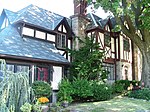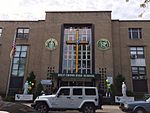Broadway station (LIRR)
1866 establishments in New York (state)Flushing, QueensLong Island Rail Road stations in New York CityRailway stations in Queens, New YorkRailway stations in the United States opened in 1866 ... and 1 more
Use mdy dates from September 2019

Broadway is a station on the Long Island Rail Road's Port Washington Branch in the East Flushing and Broadway neighborhoods of Queens, New York City. The station is east of a rail overpass at the intersection of 162nd Street and Northern Boulevard. This station contains ramps that comply with the Americans with Disabilities Act (ADA), making it fully accessible.
Excerpt from the Wikipedia article Broadway station (LIRR) (License: CC BY-SA 3.0, Authors, Images).Broadway station (LIRR)
165th Street, New York Queens County
Geographical coordinates (GPS) Address Nearby Places Show on map
Geographical coordinates (GPS)
| Latitude | Longitude |
|---|---|
| N 40.761626 ° | E -73.801383 ° |
Address
165th Street
11358 New York, Queens County
New York, United States
Open on Google Maps








